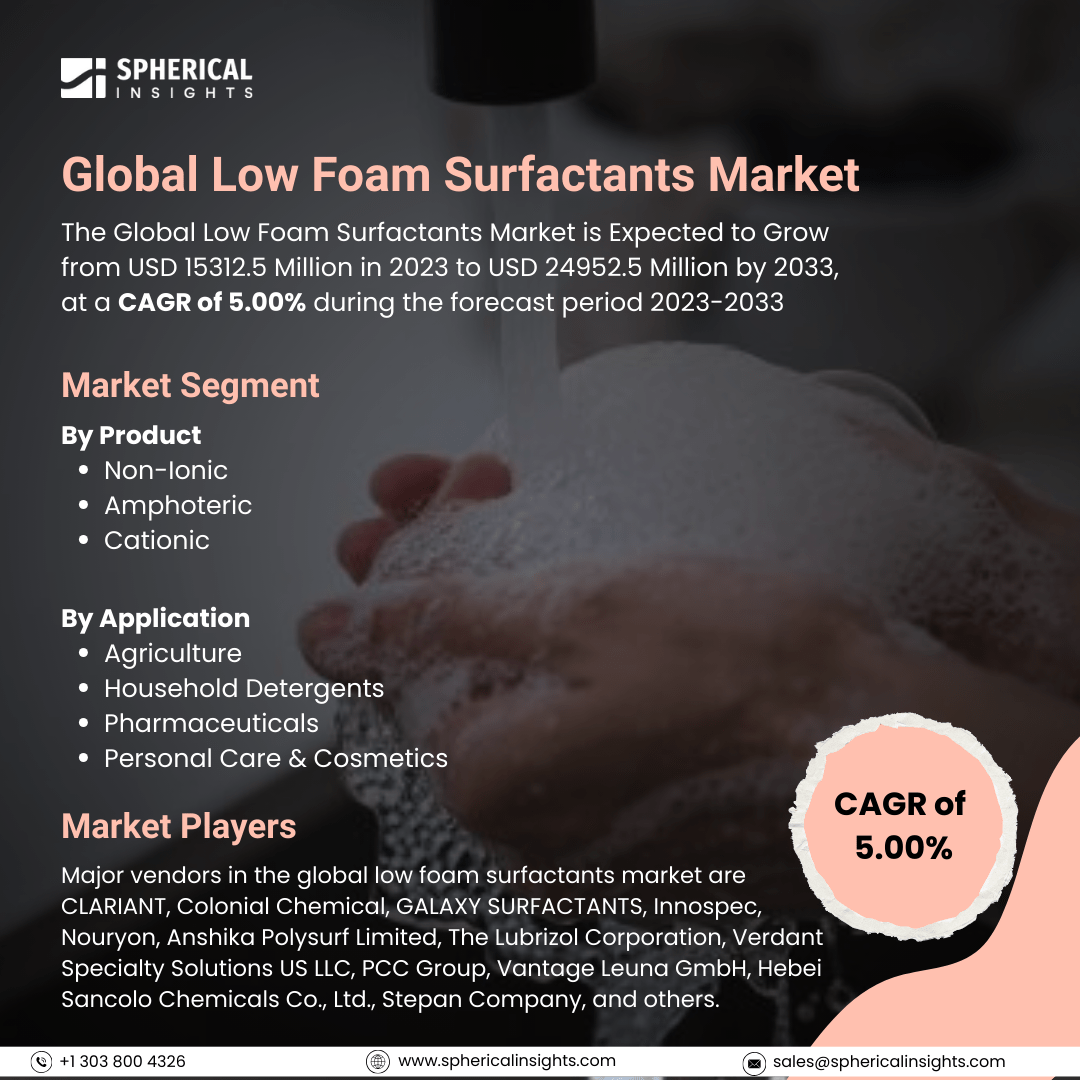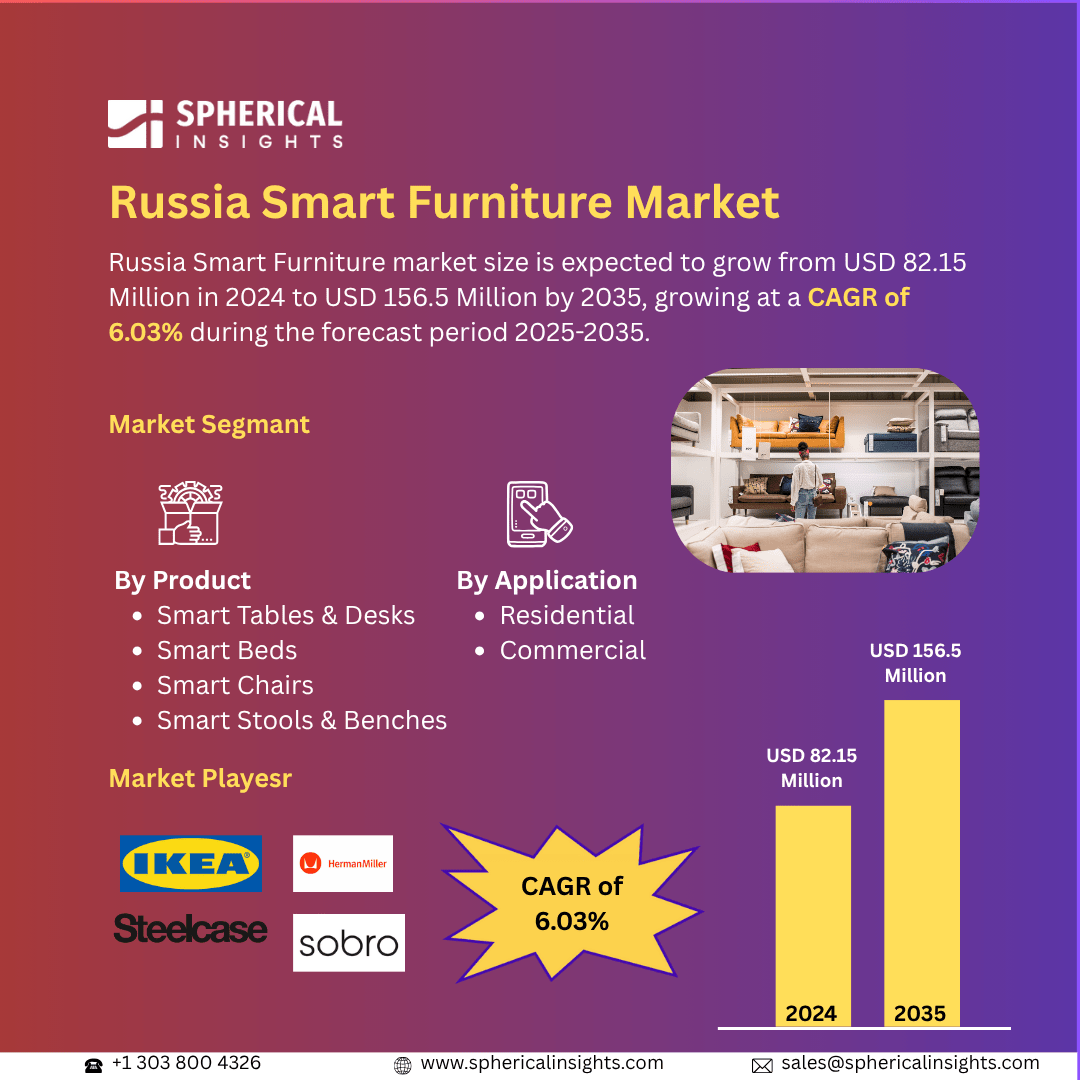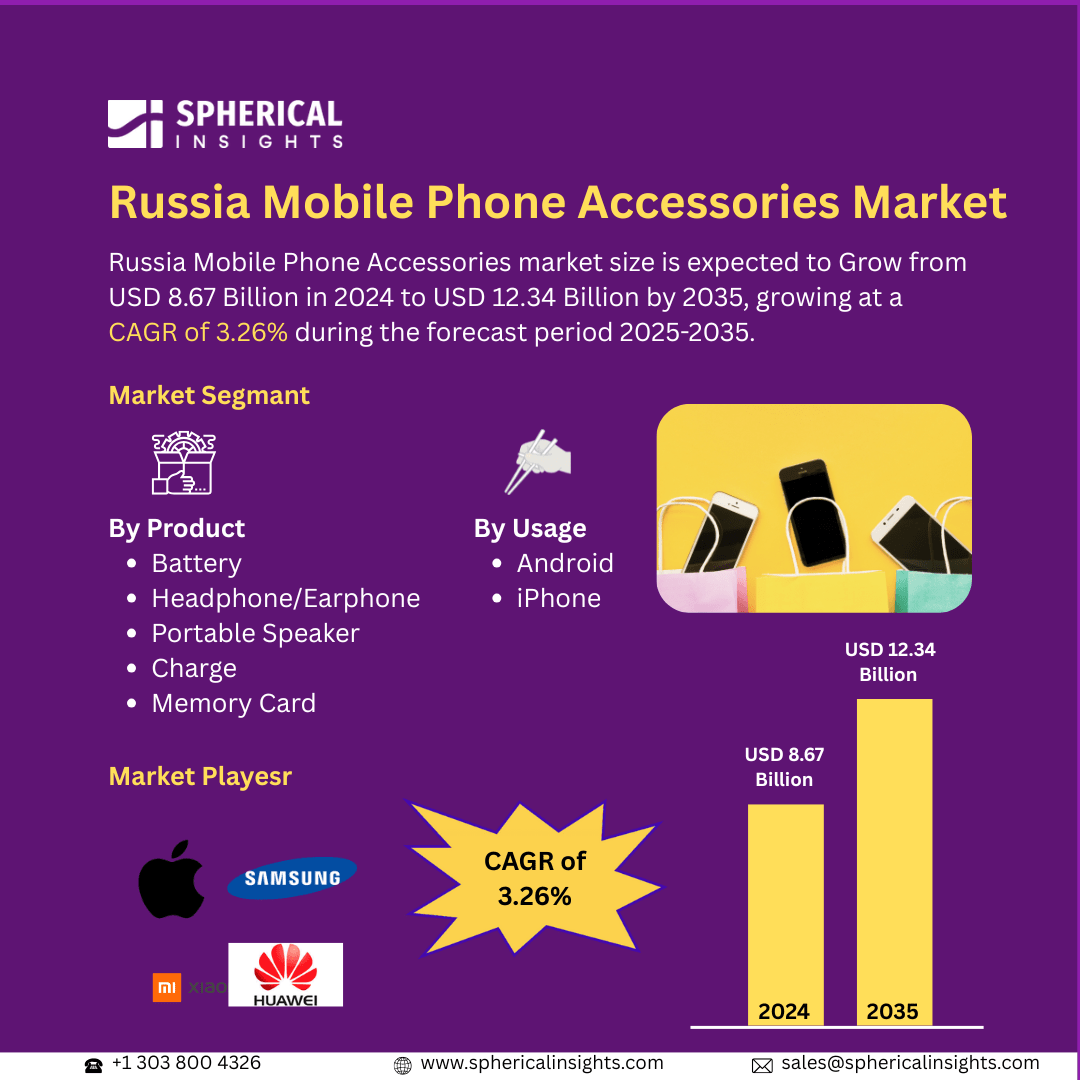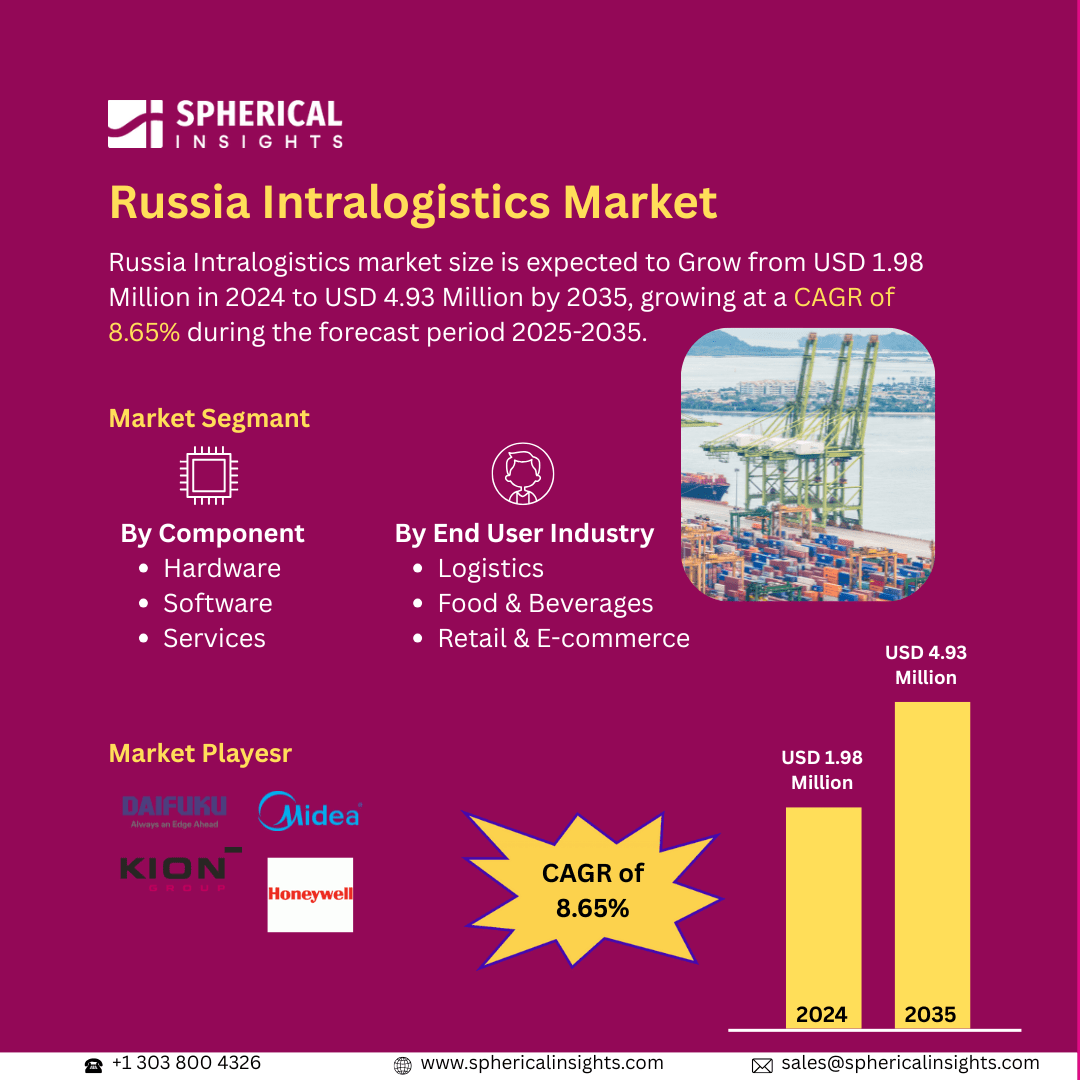Global Low Foam Surfactants Market Size to Exceed USD 24952.5 Million by 2033
According to a research report published by Spherical Insights & Consulting, The Global Low Foam Surfactants Market Size is Expected to Grow from USD 15312.5 Million in 2023 to USD 24952.5 Million by 2033, at a CAGR of 5.00% during the forecast period 2023-2033.
Browse 210 Market Data Tables and 45 Figures Spread Through 190 Pages and In-Depth TOC On the Global Low Foam Surfactants Market Size, Share, and COVID-19 Impact Analysis, By Product (Non-Ionic, Amphoteric, and Cationic), By Application (Agriculture, Household Detergents, Pharmaceuticals, and Personal Care & Cosmetics), and By Region (North America, Europe, Asia-Pacific, Latin America, Middle East, and Africa), Analysis and Forecast 2023 - 2033.
The low-foam surfactants market involves surfactants that form minimal foam, frequently utilized in products with controlled foaming needs or where excessive foam is undesirable, e.g., dishwashing detergents and industrial cleaners. One of the main features of low foam surfactants is that it can suppress foam formation well. These have additives that lower the surface tension of the liquid so that it cannot form stable bubbles. This feature proves to be very useful in food and beverage manufacturing, where foaming can disrupt processing. Furthermore, a key driver behind the worldwide market for low-foam surfactants is the heightened demand for products that are sustainable and have fewer ecological footprints. As consumer awareness of the environmental impact of their consumption rises, there has been a growing demand for green alternatives that contain lower levels of volatile organic compounds (VOCs) and are biodegradable. However, constrictions for the world market are raw material price and availability. Raw materials that play a pivotal role in surfactant manufacturing, including benzene, toluene, polyol, and phosgene, are derivatives of petroleum products and are subject to price instability. The cost pattern of these items is governed by the price and availability of the above-mentioned raw materials.
The non-ionic segment held the largest share in 2023 and is estimated to grow at a significant CAGR during the projected period.
Based on the product, the global low foam surfactants market is divided into non-ionic, amphoteric, and cationic. Among these, the non-ionic segment held the largest share in 2023 and is estimated to grow at a significant CAGR during the projected period. These surfactants have no electrical charge and are very versatile in use. These are characterized by good compatibility with other chemicals and by effective surface tension reduction. Non-ionic surfactants are commonly employed in a broad range of industries, such as cleaning agents, paints and coatings, agrochemicals, and personal care products.
The personal care & cosmetics segment held the largest share in 2023 and is estimated to grow at a significant CAGR during the forecast period.
Based on the application, the global low foam surfactants market is divided into agriculture, household detergents, pharmaceuticals, and personal care & cosmetics. Among these, the personal care & cosmetics segment held the largest share in 2023 and is estimated to grow at a significant CAGR during the forecast period. Low foam surfactants are extensively utilized in the production of numerous personal care products such as shampoos, body washes, facial cleansers, and skin care products. In shampoos and body washes, these products facilitate the generation of a rich, luxurious lather while thoroughly cleaning the hair and skin.
North America is anticipated to hold the highest share of the global low foam surfactants market over the projected period.
North America is anticipated to hold the highest share of the global foam surfactants market over the projected period. The area is dominated by a high emphasis on research and development, innovative end-user industries like personal care & cosmetics, and a dominant presence of key players. The growth in North America for low foam surfactants is attributed to reasons like the increase in bio-based surfactants, shifting customer needs, and expansion in different industries.
Asia Pacific is estimated to grow at the fastest CAGR of the global low foam surfactants market during the forecast period. The area has seen considerable development over the last few years due to factors like the rising population, urbanization, and higher disposable income. Nations like China and India have seen high urbanization and disposable income growth, resulting in a higher demand for personal care and home care products.
Company Profiling
Major vendors in the global low foam surfactants market are CLARIANT, Colonial Chemical, GALAXY SURFACTANTS, Innospec, Nouryon, Anshika Polysurf Limited, The Lubrizol Corporation, Verdant Specialty Solutions US LLC, PCC Group, Vantage Leuna GmbH, Hebei Sancolo Chemicals Co., Ltd., Stepan Company, and others.
Key Target Audience
- Market Players
- Investors
- End-users
- Government Authorities
- Consulting and Research Firm
- Venture capitalists
- Value-Added Resellers (VARs)
Recent Development
- In January 2024, Evonik declared the production of the first bio-surfactant product from its Slovakian production plant. The product, low surfactants 'Rhamnolipids' takes Evonik's biotechnology platform from its life sciences business segment, Nutrition and Care.
Market Segment
This study forecasts revenue at global, regional, and country levels from 2023 to 2033. Spherical Insights has segmented the global low foam surfactants market based on the below-mentioned segments:
Global Low Foam Surfactants Market, By Product
- Non-Ionic
- Amphoteric
- Cationic
Global Low Foam Surfactants Market, By Application
- Agriculture
- Household Detergents
- Pharmaceuticals
- Personal Care & Cosmetics
Global Low Foam Surfactants Market, By Regional
- North America
- Europe
- Germany
- UK
- France
- Italy
- Spain
- Russia
- Rest of Europe
- Asia Pacific
- China
- Japan
- India
- South Korea
- Australia
- Rest of Asia Pacific
- South America
- Brazil
- Argentina
- Rest of South America
- Middle East & Africa
- UAE
- Saudi Arabia
- Qatar
- South Africa
- Rest of the Middle East & Africa



